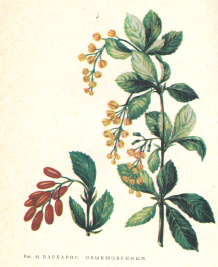Shrubs and perennial herbaceous plants with alternate leaves; flowers are regular with double perianths. The ovary is superior. The fruit is a berry or capsule.Many representatives of this family contain alkaloids, particularly berberine in the vegetative parts; berberine is obtained in the form of yellow crystals. Other alkaloids, such as oxyacanthine and others of the isoquinoline type, are also present. The fruits do not contain alkaloids but are rich in organic acids and sugars. The leaves often contain caffeic and ferulic acids; they have almost no tannins, glycosides, saponins, or essential oils.
Berberine and related alkaloids (e.g., palmatine) are also found in some other families, such as in the bark of Phellodendron amurense Rupr. (family Rutaceae), native to the Primorsky Krai, and in Thalictrum flavum (family Ranunculaceae).
BARBARY — BERBERIS
Barberry consists of branched shrubs with a robust root system. The wood is yellow. The branches are armed with three-part spines up to 2 cm long, in the axils of which sit short shoots with clusters of leaves. The leaves are obovate, with a serrated edge, narrowing into a short petiole. The inflorescences are drooping racemes. Flowers comprise 6–9 yellow sepals, 6 yellow petals, and 6 stamens. The berries are oval, very sour, with 2–3 elongated seeds. Berberine or related alkaloids are found in all species of this genus.
The leaves, bark, and roots of two species are used: Berberis amurensis Rupr. and Berberis vulgaris L..

These species differ in their leaves and petals. The leaves of Berberis vulgaris are up to 4 cm long, with entire petals. In contrast, the leaves of Berberis amurensis are significantly larger, up to 6.5 cm long, with thorny serrated edges and notched petal tips. The berries of both species are bright red, while some Central Asian species have black berries.
Berberis vulgaris grows in the European part of Russia and is widely cultivated, while Berberis amurensis is found along forest edges, cliffs, and mountain stream banks in Primorsky Krai.
Leaves are harvested from both species after flowering, trimming the short branches with scissors to avoid injury from the thorns. After fruiting in autumn, the entire shrub is cut, the roots are dug up, washed, chopped into pieces, and dried in sheds. The roots are brown on the outside and lemon-yellow inside.
All parts of both barberry species (except the berries) contain yellow berberine and several accompanying alkaloids. The roots and root bark are especially rich in berberine. Berberine exhibits cholagogue (bile-stimulating) properties, enhances uterine contractions, and lowers blood pressure. Other barberry species with higher berberine content are being studied.
The medicinal raw material includes barberry leaves collected after flowering. All parts of the plant contain alkaloids. The presence of essential oils and tannins has also been confirmed. Of the alkaloids, only berberine is currently used in medicine. It helps lower blood pressure and has hemostatic properties.
Barberry preparations are used as cholagogues.
Barberry tincture is prescribed as a uterotonic at 30 drops, 3 times a day. As a cholagogue, berberine sulfate is prescribed in tablet form at 0.005–0.01 g, 3 times a day before meals. Barberry bark is also part of “Cholelitin.” In Central Asia and India, barberry is used to treat leishmaniasis.
